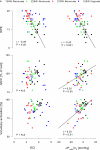Reduced muscle activation during exercise related to brain oxygenation and metabolism in humans
- PMID: 20403976
- PMCID: PMC2901984
- DOI: 10.1113/jphysiol.2009.186767
Reduced muscle activation during exercise related to brain oxygenation and metabolism in humans
Abstract
Maximal exercise may be limited by central fatigue defined as an inability of the central nervous system to fully recruit the involved muscles. This study evaluated whether a reduction in the cerebral oxygen-to-carbohydrate index (OCI) and in the cerebral mitochondrial oxygen tension relate to the ability to generate a maximal voluntary contraction and to the transcranial magnetic stimulated force generation. To determine the role of a reduced OCI and in central fatigue, 16 males performed low intensity, maximal intensity and hypoxic cycling exercise. Exercise fatigue was evaluated by ratings of perceived exertion (RPE), arm maximal voluntary force (MVC), and voluntary activation of elbow flexor muscles assessed with transcranial magnetic stimulation. Low intensity exercise did not produce any indication of central fatigue or marked cerebral metabolic deviations. Exercise in hypoxia (0.10) reduced cerebral oxygen delivery 25% and decreased 11+/-4 mmHg (P<0.001) together with OCI (6.2+/-0.7 to 4.8+/-0.5, P<0.001). RPE increased while MVC and voluntary activation were reduced (P<0.05). During maximal exercise declined 8+/-4 mmHg (P<0.05) and OCI to 3.8+/-0.5 (P<0.001). RPE was 18.5, and MVC and voluntary activation were reduced (P<0.05). We observed no signs of muscular fatigue in the elbow flexors and all control MVCs were similar to resting values. Exhaustive exercise provoked cerebral deoxygenation, metabolic changes and indices of fatigue similar to those observed during exercise in hypoxia indicating that reduced cerebral oxygenation may play a role in the development of central fatigue and may be an exercise capacity limiting factor.
Figures


 , changes in cerebral mitochondrial oxygen tension; RPE, ratings of perceived exertion; MVC, maximal voluntary contraction.
, changes in cerebral mitochondrial oxygen tension; RPE, ratings of perceived exertion; MVC, maximal voluntary contraction.Similar articles
-
The effect of a contralateral contraction on maximal voluntary activation and central fatigue in elbow flexor muscles.Exp Brain Res. 2003 Jun;150(3):308-13. doi: 10.1007/s00221-003-1379-7. Epub 2003 Apr 3. Exp Brain Res. 2003. PMID: 12677313
-
Neuromuscular Fatigue during Prolonged Exercise in Hypoxia.Med Sci Sports Exerc. 2017 Mar;49(3):430-439. doi: 10.1249/MSS.0000000000001118. Med Sci Sports Exerc. 2017. PMID: 27753741
-
The effect of sustained low-intensity contractions on supraspinal fatigue in human elbow flexor muscles.J Physiol. 2006 Jun 1;573(Pt 2):511-23. doi: 10.1113/jphysiol.2005.103598. Epub 2006 Mar 23. J Physiol. 2006. PMID: 16556656 Free PMC article.
-
Cerebral perturbations during exercise in hypoxia.Am J Physiol Regul Integr Comp Physiol. 2012 Apr 15;302(8):R903-16. doi: 10.1152/ajpregu.00555.2011. Epub 2012 Feb 8. Am J Physiol Regul Integr Comp Physiol. 2012. PMID: 22319046 Review.
-
Evidence for a supraspinal contribution to human muscle fatigue.Clin Exp Pharmacol Physiol. 2006 Apr;33(4):400-5. doi: 10.1111/j.1440-1681.2006.04363.x. Clin Exp Pharmacol Physiol. 2006. PMID: 16620309 Review.
Cited by
-
A Mixed-Method Approach of Pre-Cooling Enhances High-Intensity Running Performance in the Heat.J Sports Sci Med. 2021 Mar 1;20(1):26-34. doi: 10.52082/jssm.2021.26. eCollection 2021 Mar. J Sports Sci Med. 2021. PMID: 33707983 Free PMC article.
-
Differential Brain and Muscle Tissue Oxygenation Responses to Exercise in Tibetans Compared to Han Chinese.Front Physiol. 2021 Feb 24;12:617954. doi: 10.3389/fphys.2021.617954. eCollection 2021. Front Physiol. 2021. PMID: 33716766 Free PMC article.
-
AltitudeOmics: on the consequences of high-altitude acclimatization for the development of fatigue during locomotor exercise in humans.J Appl Physiol (1985). 2013 Sep 1;115(5):634-42. doi: 10.1152/japplphysiol.00606.2013. Epub 2013 Jun 27. J Appl Physiol (1985). 2013. PMID: 23813531 Free PMC article.
-
Role of CO2 in the cerebral hyperemic response to incremental normoxic and hyperoxic exercise.J Appl Physiol (1985). 2016 Apr 15;120(8):843-54. doi: 10.1152/japplphysiol.00490.2015. Epub 2016 Jan 14. J Appl Physiol (1985). 2016. PMID: 26769951 Free PMC article.
-
Autonomic dysfunction and exercise intolerance in post-COVID-19 - An as yet underestimated organ system?Int J Clin Health Psychol. 2024 Jan-Mar;24(1):100429. doi: 10.1016/j.ijchp.2023.100429. Epub 2023 Dec 14. Int J Clin Health Psychol. 2024. PMID: 38348143 Free PMC article.
References
-
- Borg G. Simple rating for estimation of perceived exertion. In: Borg G, editor. Physical Work and Effort. New York: Pergamon; 1975. pp. 39–46.
-
- Bradac GB, Simon RS, Heidsieck CH. Angiographically verified transient alteration of intercranial arteries and veins in dependence of different CO2 tension. Neuroradiology. 1976;10:257–262. - PubMed
-
- Dalsgaard MK. Fuelling cerebral activity in exercising man. J Cereb Blood Flow Metab. 2006;26:731–750. - PubMed
Publication types
MeSH terms
Substances
LinkOut - more resources
Full Text Sources
Other Literature Sources
Medical

